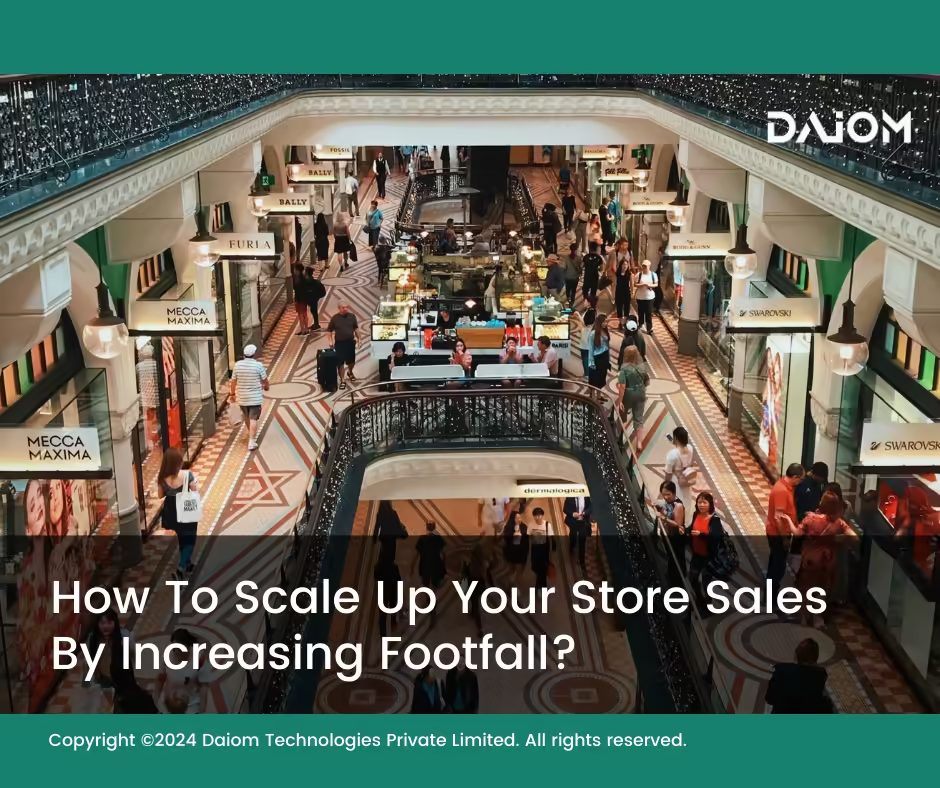Summary:
Boosting in-store sales is a big challenge for brands. But it boils down to three things – getting people in the door, converting them into buyers, and increasing how much they spend. You can attract more customers with omnichannel marketing and a great in-store experience. Once they’re inside, improve conversion by training staff, optimizing store layouts, and speeding up checkouts. AI tools like Tango Eye help track foot traffic and customer behavior for better insights. Focus on footfall, conversion, and AOV, and use digital marketing like WhatsApp and local SEO to drive sales and build lasting loyalty.
One of the biggest challenges for brands in today’s retail landscape is effectively increasing sales. Many businesses succeed in understanding their online sales channels but often struggle when it comes to driving higher sales at physical store locations.
To tackle this issue, it’s essential to break down in-store sales into three critical components: footfall, conversion rate, and average order value (AOV). Each of these plays a key role in driving the overall success of your store.
This blog discusses the importance of store footfall in driving higher store sales. It highlights the strategies ranging from attracting more customers through Omnichannel marketing to improving the in-store experience.
People are always going to go shopping. A lot of our effort is just ‘how do we make the retail experience a great one?
Phillip Green, Chairman, Arcadia Group
Table of Contents:
- Understanding Store Sales
- What Affects Footfall?
- What is the Importance of Footfall Data?
- How To Increase Conversion Rate?
- How to Measure Footfall?
- How To Boost Average Order Value (AOV)?
- Key Metrics To Consider Before Measuring Footfall
- Different Ways to Increase Store Footfall
- Digital Marketing Initiatives To Drive Footfall
- Conclusion
1. Understanding Store Sales
When it comes to store sales (in physical stores), there are three main things that affect how much a store sells:
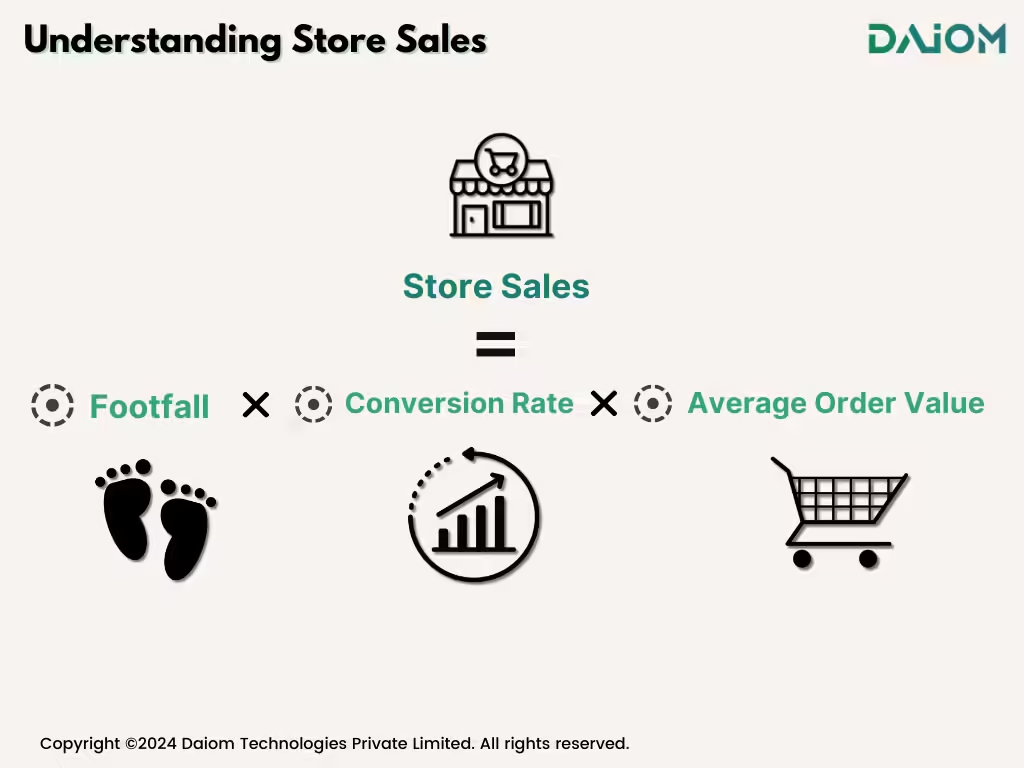
When sales are low, the common excuse is to blame the low number of visitors (footfall). But there’s more to it. To really understand why sales are down, you need to look at all three parts: footfall, conversion rate, and AOV.
- Footfall: This is the number of people who come into the store.
- Conversion Rate: How many of those people actually buy something.
- Average Order Value (AOV): How much each customer spends when they buy something.
2. What Affects Footfall?
Footfall can be influenced by several factors:
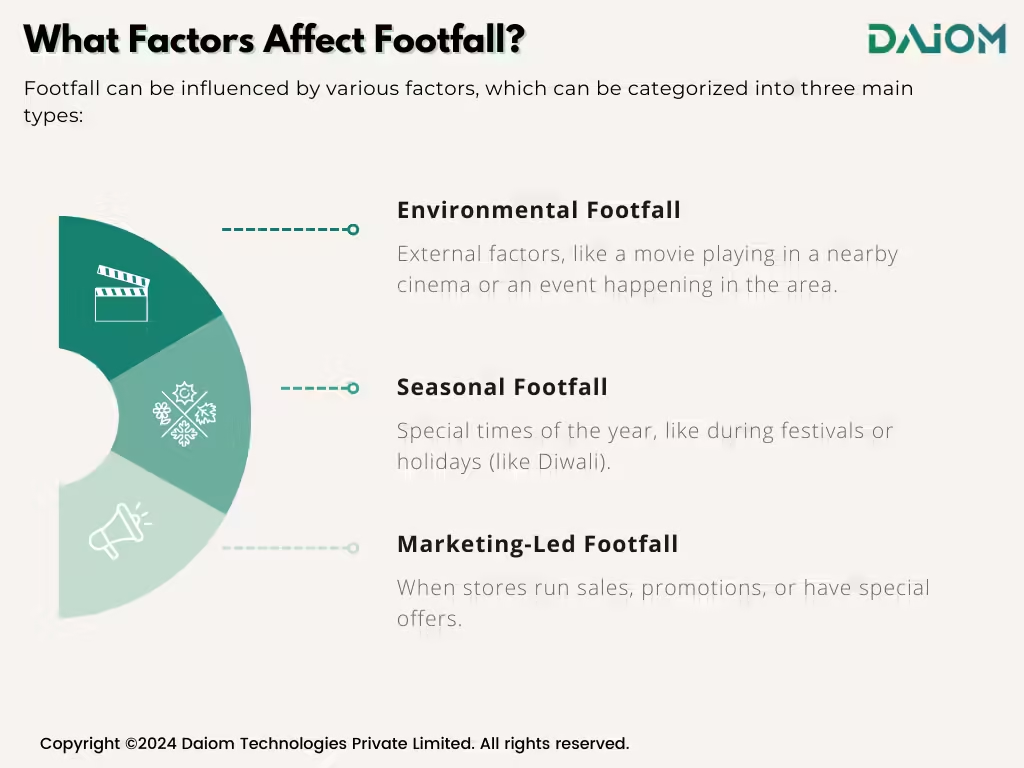
Marketing-Led Footfall: This type of footfall occurs when stores implement sales, promotions, or special offers to attract customers. These marketing strategies can significantly increase store visits, as shoppers are often motivated by discounts and exclusive deals. Management can directly influence this by planning targeted marketing campaigns to draw in more customers.
Seasonal Footfall: Certain times of the year, such as festivals or holidays (like Diwali), naturally increase foot traffic as people tend to shop more during these periods. Seasonal events create a festive atmosphere and often involve traditions that encourage shopping, leading to higher store visits.
Environmental Footfall: This refers to external factors that can affect store visits, such as nearby events or attractions. For example, a popular movie showing at a nearby cinema or a local event can draw in more visitors to the store. These factors are often outside management’s control but can be leveraged to boost footfall when timing promotions or store hours accordingly.
Management has the most control over omnichannel marketing-led footfall, so focusing on good offers and promotions can help increase visitors.
3. What is the Importance of Footfall Data?
Once you have accurate footfall data, you can make better decisions. For example, if footfall is strong but conversions are low, this signals a need to understand why people aren’t making purchases.
Potential issues could include:
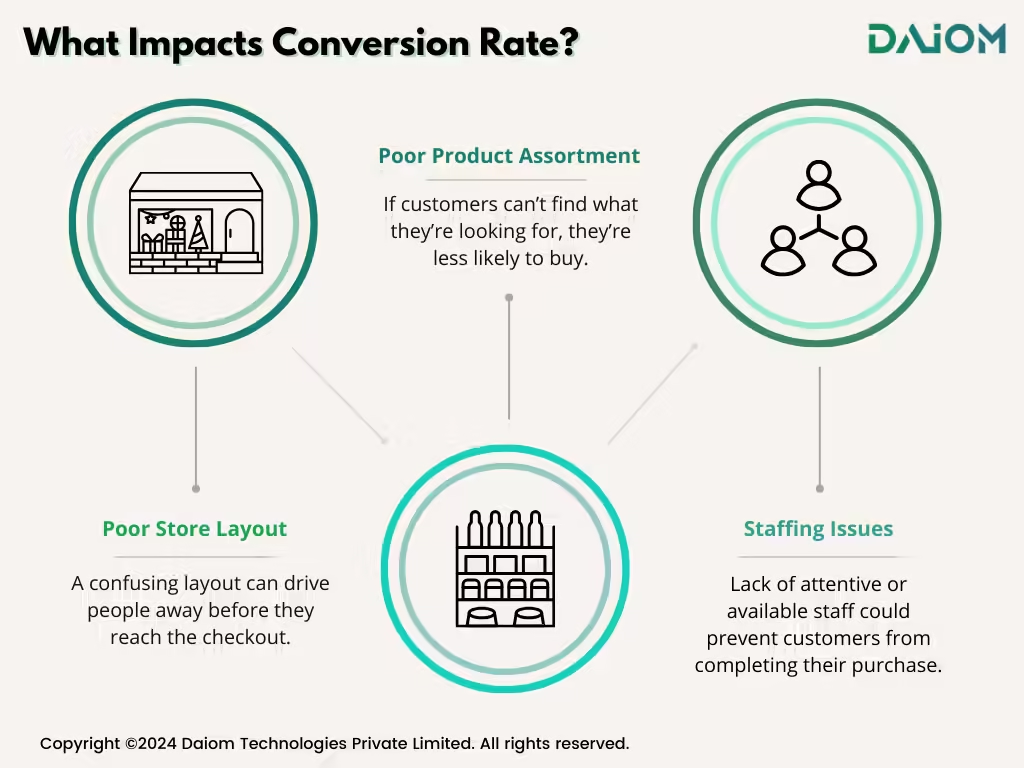
- Poor Product Assortment: If customers can’t find what they’re looking for, they’re less likely to buy.
- Staffing Issues: Lack of attentive or available staff could prevent customers from completing their purchase.
- Store Layout or Experience: A confusing layout or negative in-store experience can drive people away before they reach the checkout.
By understanding these, you can pinpoint specific areas for improvement and implement targeted strategies to address them.
4. How To Increase Conversion Rate?
Once people come into the store, the next goal is to get them to buy something. Here’s what influences that:
- Staff Training: Train staff to provide excellent customer service, helping customers find what they need.
- In-Store Promotions: Run special deals or promotions that encourage purchases.
- Store Layout Optimization: Arrange your store in a way that makes it easy and inviting for customers to browse and buy.
- Base Staff Levels on Visitors: Ensure you have enough staff based on the number of visitors, not just past sales, to meet customer needs during peak hours.
- Phygital Experiences: Combine the physical and digital experience by offering interactive screens, apps, or digital product information to enhance in-store engagement.
- Reduce Friction at Checkouts: Speed up the checkout process with efficient systems and staff to avoid long lines and frustration.
5. How to Measure Footfall?
Footfall is a tricky thing to measure. In the past, people used basic methods like:
- Manual Measurement: This method involves manually counting people as they enter and exit the store, making it the least accurate option.
- New Camera System: Companies install new camera systems to automatically track foot traffic. While accurate, this method is costly due to the large number of cameras needed.
- Using Existing Cameras: Some companies use their existing camera systems to measure footfall, which is more affordable but depends on the quality of the current cameras.
The manual method is the least accurate. The new camera system offers better accuracy but is expensive due to the number of cameras needed. The third option is effective but depends heavily on the quality of the existing cameras.
But, today there are other platforms that offer better solutions in tracking footfall like:
Tango Eye
Platforms like Tango Eye offer advanced solutions for tracking footfall in physical stores. Tango Eye uses AI-powered video analytics to monitor customer movement, helping retailers gain valuable insights into foot traffic, customer behavior, and store performance. The platform tracks how many customers enter, how long they stay, and their movement patterns within the store.
Other platforms offering similar footfall tracking solutions include:
- Wobot – Specializes in AI video analytics to monitor foot traffic, customer interactions, and store operations for real-time insights.
- Zebra Technologies India – Provides advanced tracking tools that offer a detailed analysis of customer behavior, movement, and store engagement.
- Infilect – Utilizes AI to help retailers analyze footfall and customer engagement, focusing on improving in-store experiences and product placements.
These platforms empower retailers to make data-driven decisions, improve store layouts, and optimize staff deployment to enhance customer experience and drive sales.
6. How To Boost Average Order Value (AOV)?
To increase how much each customer spends (AOV), stores can do things like:
- Upselling: Suggest additional products or upgrades that complement what the customer is already buying.
- Loyalty Programs: Offer rewards and discounts to loyal customers, encouraging them to spend more on each visit.
By closely monitoring AOV and experimenting with different strategies, brands can find the optimal product mix and promotional strategies to boost their in-store sales.
7. Key Metrics To Consider Before Measuring Footfall
When businesses want to understand how many people visit their store, they need to take a look at some important metrics. Here are some key metrics to consider:
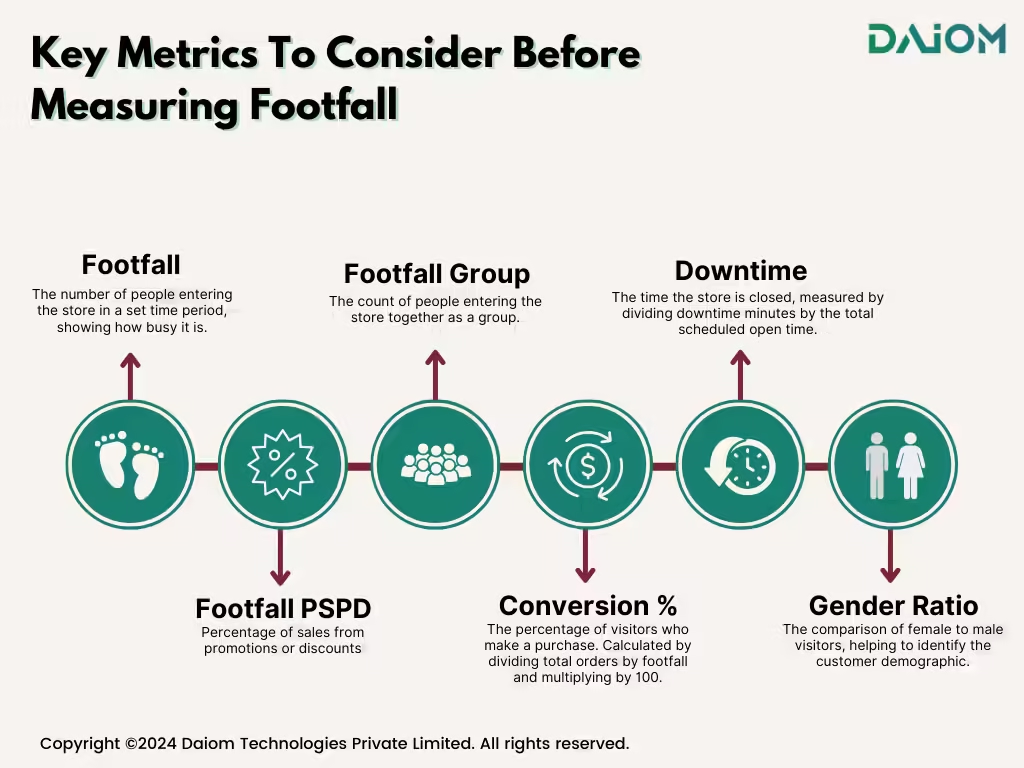
- Footfall: This is the total number of people who enter the store during a specific time period. It helps to see how busy the store is.
- Footfall PSPD: This stands for “Footfall Per Store Per Day.” It tells us how many people come into the store each day.
- Footfall Group: This counts the total number of people who come into the store together as a group during a specific time.
- Conversion %: This shows how many visitors actually made a purchase. To find this percentage, you take the total number of orders, divide it by the total footfall, and then multiply by 100. It helps businesses know how good they are at selling things.
- Downtime: This is the amount of time when the store is not open for customers. To find this, you take the total downtime in minutes and divide it by the total time the store was supposed to be open in minutes.
- Gender Ratio: This compares the number of females to the number of males who visit the store. It helps businesses understand who their customers are.
8. Different Ways to Increase Store Footfall

- Local Marketing: Promote your store within the community through flyers, ads, or social media.
- Community Events: Organize or participate in events that attract locals.
- QR Codes: Customers can scan a code to quickly access product info, discounts, or exclusive deals, while helping stores gather data on interested shoppers.
- Loyalty Programs: Customers earn points for purchases, redeemable for discounts or free items, encouraging repeat business and making them feel rewarded.
- Free Trials: Offering free samples or trials lets customers experience a product before committing to a purchase, boosting interest.
By doing this, stores can gather more data on both buyers and non-buyers, helping them understand why some people don’t purchase and how to improve the customer experience.
9. Digital Marketing Initiatives To Drive Footfall
Beyond measuring and analyzing footfall, businesses can also take proactive steps to increase foot traffic. Digital marketing plays a crucial role in this process. Here’s how:
- WhatsApp Marketing: Use WhatsApp to send direct messages about new products and special offers, keeping customers engaged and informed.
- Local SEO: Optimize your Google profile with accurate details and encourage customer reviews to enhance visibility in local search results.
- Engaging Social Media Content: Share eye-catching posts and videos showcasing your store’s unique features and events to draw attention on social media platforms.
- Strong Digital Identity: Build a digital presence by updating your Google My Business profile with appealing photos and positive customer reviews, making your store more inviting.
- Influencer Partnerships: Collaborate with influencers to promote your store through authentic experiences, attracting their followers to visit.
Incorporating digital marketing into your strategy ensures that your store remains competitive and aligned with today’s shopper expectations, enhancing sales across the board.
You walk into a retail store, whatever it is, and if there’s a sense of entertainment and excitement and electricity, you wanna be there.
Howard Schultz, Former CEO, Starbucks
10. Conclusion
To drive higher store sales, it’s important to balance footfall, conversion, and AOV. Attracting more customers, turning them into buyers, and encouraging them to spend more will create a solid foundation for retail growth.
With the right tools to measure footfall and insights into how to improve conversion rates and AOV, retailers can transform their in-store performance.
Combining these strategies with a smart digital marketing approach can create a powerful omnichannel strategy that drives success across all sales channels.
By implementing these strategies, you’ll not only see an increase in sales but also build a loyal customer base that contributes to long-term success.
Also read our blog – How To Drive Store Footfall In An Omnichannel Digital World?
Subscribe to our NEWSLETTER!


